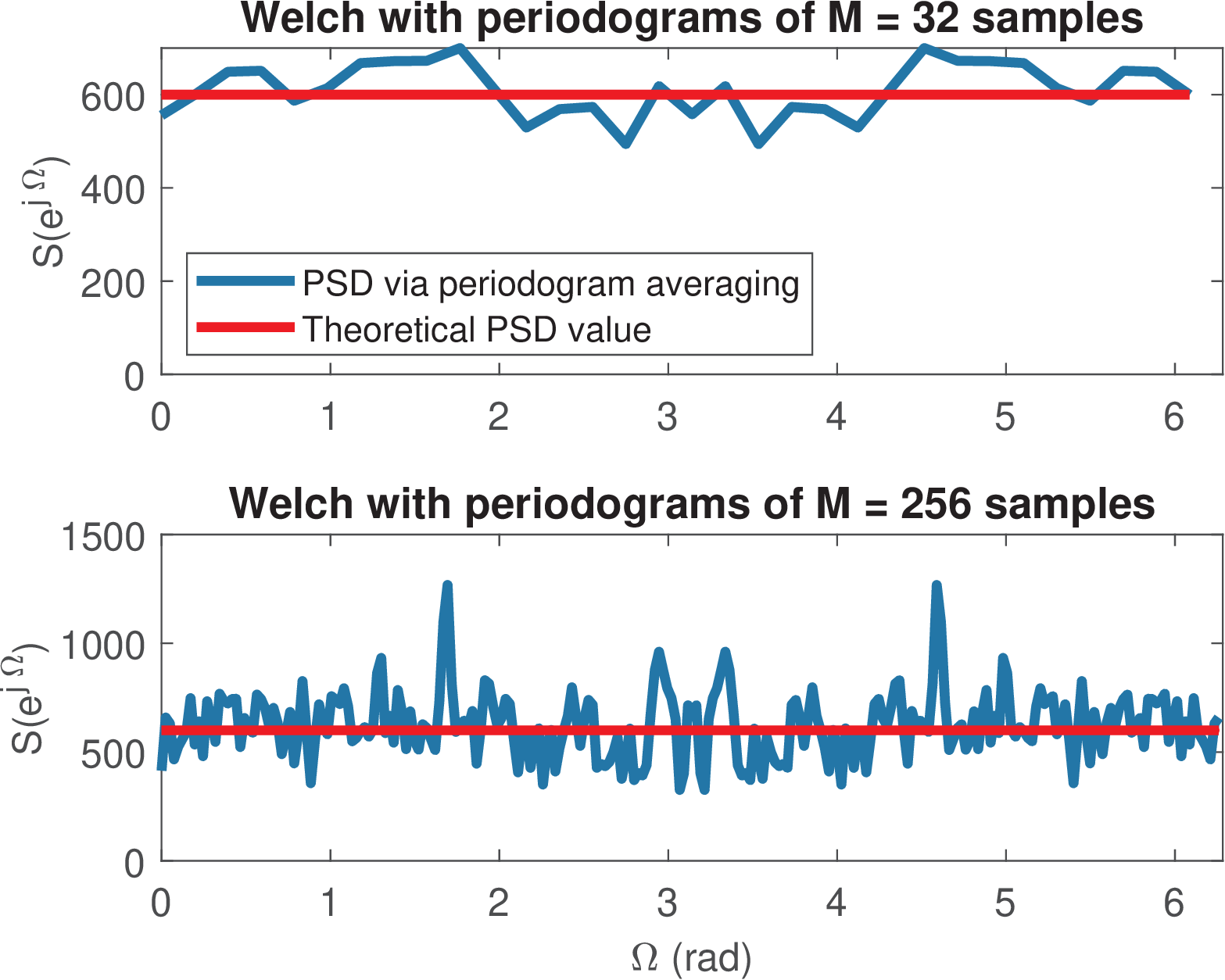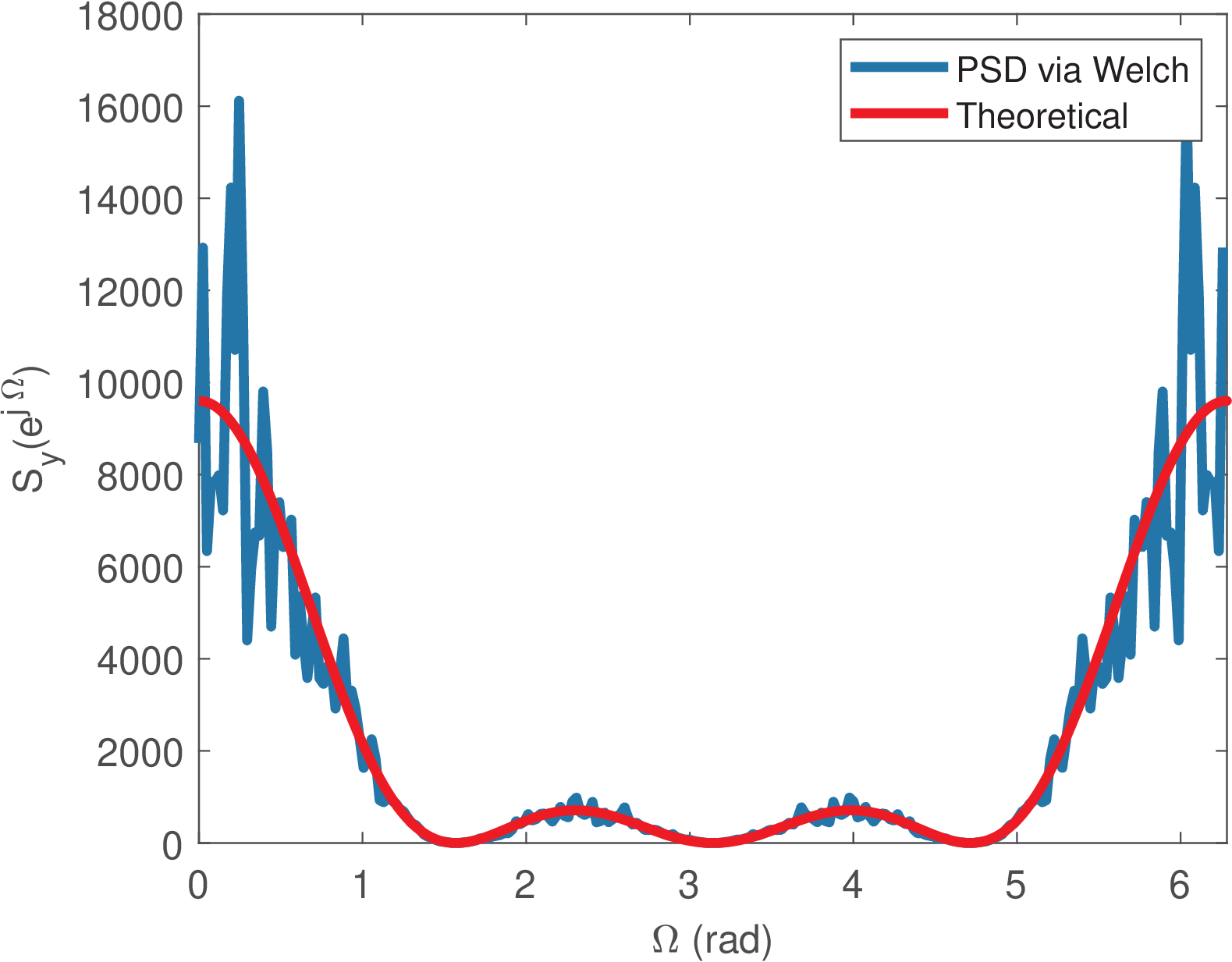4.9 Nonparametric PSD Estimation via Welch’s method
This section discusses Welch’s method, one of the most popular nonparametric PSD estimation method.
4.9.1 The periodogram variance does not decrease with N
It may seem counterintuitive but, as Figure 4.34 indicates, increasing the number of samples does not decrease the variance of the periodogram estimates .
In fact, it is well-known in spectral analysis theory11 that the periodogram is an unbiased estimator of the true PSD , i. e.,
In other words, the average periodogram converges to the right values as increases.
However, the variance of the periodogram estimator is approximately even for large . This is a consequence of a result that is valid under mild conditions:
|
| (4.56) |
where tends to zero when . In other words, the standard deviation of the periodogram is approximately as large as the spectrum it should estimate. Using windows such as Hamming and Hann can improve the spectral analysis, but does not help with respect to the variance of the periodogram.
One may expect that increasing the number of samples would lead to a better estimate of the PSD. In fact, the estimation does improve, but with respect to its frequency resolution , not the variance.
4.9.2 Welch’s method for PSD estimation
The main strategy to decrease the variance of a PSD estimation is to split the available data into segments of samples each, calculate the periodogram for each segment and then take their average. Methods such as Bartlett’s and Welch’s are based on this principle. The disadvantage of using less () samples is that the frequency resolution decreases (from to ).
The main distinction between Bartlett’s and Welch’s methods is that the latter tries to combat the decrease in by overlapping segments, such that for a given , the value of can be larger than , where is the total number of available samples. For example, an overlap of 50% of segments of length means that the first segment corresponds to samples with indices , the second segment has samples with , the third with and so on.
In Matlab/Octave, the command Sx=pwelch(x) estimates a PSD via Welch’s method using default values (, Hamming window and an overlap of 50%). An example of a complete command is
where window is the window, Num_overlap is the number of samples that are shared between two neighboring segments, N_fft is the number of FFT points used for calculating the periodograms, Fs is the sampling frequency and ’twosided’ can be used to force pwelch to return values from 0 to , even if the signal is real. The number of samples per segment corresponds to the window length. The companion function ak_psd.m illustrates how to invoke pwelch.m and is convenient when the sampling frequency is given in Hz.

Example 4.23. Variance reduction with Welch’s method. Listing 4.18 provides an example of using pwelch for PSD estimation of the same signal as Figure 4.34 and leads to Figure 4.36. The top plot was obtained with Nfft=32 and then, the code was modified to use Nfft=256 and generate the bottom plot. Note that the total number of samples is N=3000 in both cases. The standard deviations among the periodograms were 46.5 and 132.0, respectively. The smaller Nfft, a larger number of periodograms is calculated and their averaging reduces the variance.
1N = 3000; %total number of signal samples 2Nfft = 32; %segment length M and also FFT-length 3Fs = 1; %assumed bandwidth for discrete-time signal 4power_x = 600; %noise power in Watts 5x=sqrt(power_x) * randn(1,N); %Gaussian white noise 6[Sk,F]=pwelch(x,hamming(Nfft),[],Nfft,Fs,'twosided'); %Parameter [] 7%is because in Matlab it is num. samples while Octave is percent (%) 8disp(['Periodogram standard deviation=' num2str(std(Sk))]) 9plot(2*pi*F,Sk) %periodogram with Fs=1 is discrete-time PSD 10hold on, plot(w,power_x*ones(1,length(w)),'r') %PSD theoretical value
When comparing the plots in Figure 4.36 with the bottom plot in Figure 4.34, which also used samples, it is evident that averaging periodograms (for example, via Welch’s method) decreases the variance. Figure 4.36 also illustrates the tradeoff between variance reduction and frequency resolution as the top graph with is much smoother than the bottom one with .
A detail is that Listing 4.18 uses the default of the window overlap (the third argument of pwelch.m as []) because Octave assumes it is a percentage while Matlab assumes it is the number of samples.
Example 4.24. Estimating the PSD of filtered white noise via Welch’s method.

Listing 4.19 illustrates an application of (Eq. (4.47)), where the system impulse response is h=[1,1,1,1] and is a sinc.
1N = 3000; %total number of signal samples 2L = 4; %number of non-zero samples of h[n] 3power_x = 600; %noise power in Watts 4x=sqrt(power_x) * randn(1,N); %Gaussian white noise 5h=ones(1,L); %shaping pulse with square waveform 6y=conv(h,x); %filter signal x with filter 7Nfft = 256; %segment length M and also FFT dimension 8Fs = 2*pi; %sampling frequency for discrete-time PSD 9[Sy_pwelch,w]=pwelch(y,hamming(Nfft),[],Nfft,Fs,'twosided'); 10H=fft(h,4*N); %DTFT (sampled) of the impulse response 11Sy_th=power_x*abs(H).^2; %PSD theoretical expression 12plot(w,2*pi*Sy_pwelch); hold on %scale by 2*pi to get disc.time PSD 13plot(linspace(0,2*pi,length(H)),power_x*abs(H).^2,'r')
Listing 4.19 was used to generate Figure 4.37, where one can notice that, even with the averaging used in pwelch, the variance continues proportional to the PSD magnitude, as indicated by Eq. (4.56).
Example 4.25. Welch’s method using the Goertzel algorithm. Note that in Matlab, when the call to pwelch specifies the frequency points, pwelch can use the Goertzel algorithm instead of an FFT. An example is the following code:
1x=randn(1,10000); Fs=1e4; %some random vector and sampling freq. 2f=linspace(-Fs/2,Fs/2,1024); %create a frequency axis 3Px=pwelch(x,hamming(1024),512,f,Fs); %Octave has distinct syntax! 4plot(f,10*log10(Px)); %show PSD from -Fs/2 to Fs/2
The Goertzel algorithm can slow down the computations when compared to the FFT-based PSD estimation because it targets situations in which the frequencies are not uniformly spaced such as in DTMF detection algorithms (see Figure 4.50).